
Want to be the world’s greatest manager? We’ve got you covered. Whether you’re just starting out or you’re already a seasoned pro.
Introduction – what to expect from this article
This is your one-stop spot for everything you need to know to help you succeed and excel in your management role. If you only ever read one article on the subject of being a good manager, make sure it’s this one.
Below, you’ll find detailed explanations of key concepts, plenty of practical and actionable advice and a ton of useful hints and tips.
I’ve also scoured the web and unearthed a truckload of the very best resources to help you increase efficiency, foster respect and solve problems like a boss.
So, grab a cup of coffee and let’s get stuck in.
Table of Contents
- 1 Introduction – what to expect from this article
- 2 Everything you need to know about training.
- 3 Tips and resources for training in 2020.
- 4 How to organise your team.
- 5 Use project management software to stay organised.
- 6 The benefits of effective communication.
- 7 10 tips to become a better communicator.
- 8 Leading and motivating.
- 9 How to motivate people.
- 10 Top 5 ways to motivate employees.
- 11 Final thoughts.
Everything you need to know about training.
Why training is important.
1 in 3 workers leave their organisation in the first 12 months and 74% of workers feel that they’re not achieving their full potential.
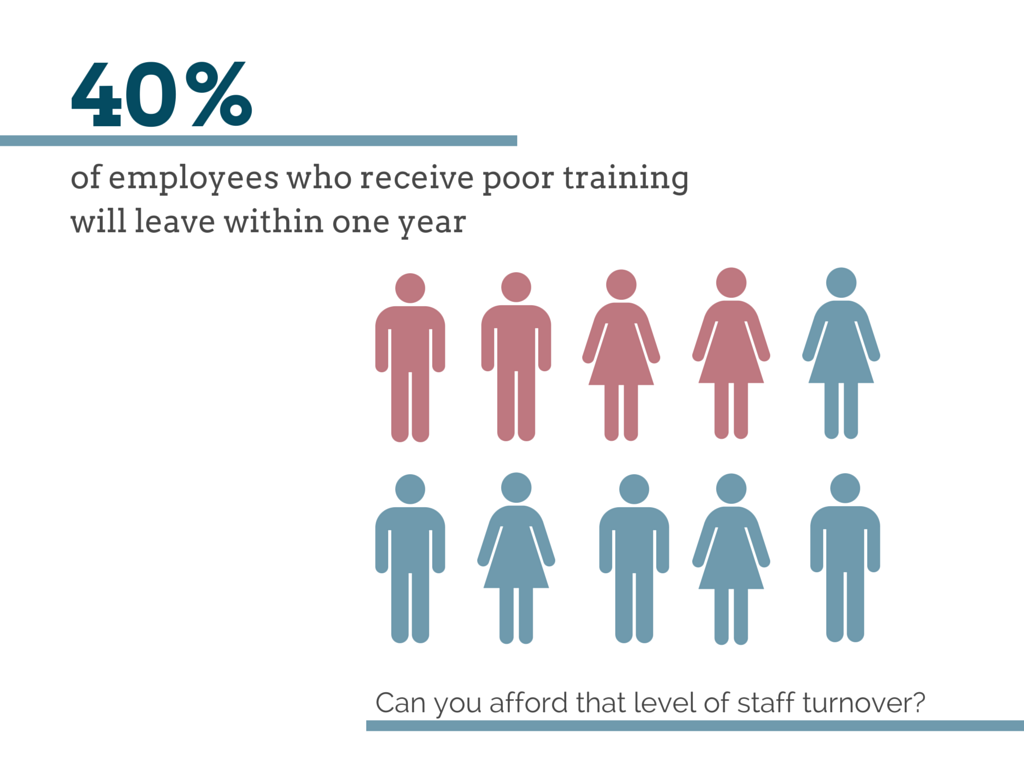
Source
When a single worker jumps ship, it can cost a company up to 3 times that person’s salary.
Employees today, and this is particularly true of millennials, expect a thoughtfully designed working environment. This includes having ample opportunity to learn and improve their skills.
If you want to attract the best staff (and hang on to them) in 2020 and beyond, you need an attractive training programme.
Having a good training programme, one which allows your staff to grow and to explore their work-related interests is entirely worthwhile. It can increase retention rates, speed up product development, and boost productivity and profitability.
Given the benefits, it’s surprising that so many companies fall flat when it comes to training. This is largely because most organisations put all of their emphasis on (and all of their resources into) understanding the customer and forget about one of their most valuable assets – their workers.
Companies spend billions to make sure they know their customers every pain point and desire. But, when you consider the amount of effort that goes into figuring out the pain points and desires of employees, you’ll often discover a harsh contrast.
Listening to your employees and striving to overcome their pain points with your training can help to streamline processes and create a better work environment.
Training also demonstrates to your workforce that you value their skills and talents and that you’re willing to invest in them.
Properly implemented then, training improves loyalty and helps to foster a positive and stimulating working environment.
In her insightful Ted talk, Harvard business graduate Diana Dosik highlights the benefits of giving more thought to your employees.
She explains that there are huge potential gains for those companies who are willing to pay a little more attention to their staff.
Types of intelligence and useful training tactics.
Have you ever watched the Apprentice? Nobody ever wants to be a team leader on the first task and there’s a very good reason for that. In order to successfully lead a team you need to know the strengths and weaknesses of your staff.
The trouble is, this accepted wisdom is rarely applied when it’s time to train.
Did you know that the learning styles of your team members are likely to be as unique and diverse as their individual skill sets?
There are many different types of intelligence, so the way information is absorbed and processed by individual staff members is going to vary. This is something that you should consider if you want your training programme to be a success.
The best managers understand that everyone learns differently and they adapt their training methods accordingly.
As a manager, understanding the different ways in which people learn will help you to create more engaging and effective training sessions that will, in turn, increase productivity and profits.
So what exactly are the different learning styles, and how can you incorporate them into your training?
In 1983, developmental psychologist, Howard Gardner, identified nine core types of intelligence. They are:
- Spatial / Visual
- Naturalist
- Musical
- Logical-mathematical
- Bodily-kinesthetic
- Linguistic
- Intra-personal
- Interpersonal
- Existential
It’s important to note that these types of intelligence are not mutually exclusive. They can, (and often do) overlap.
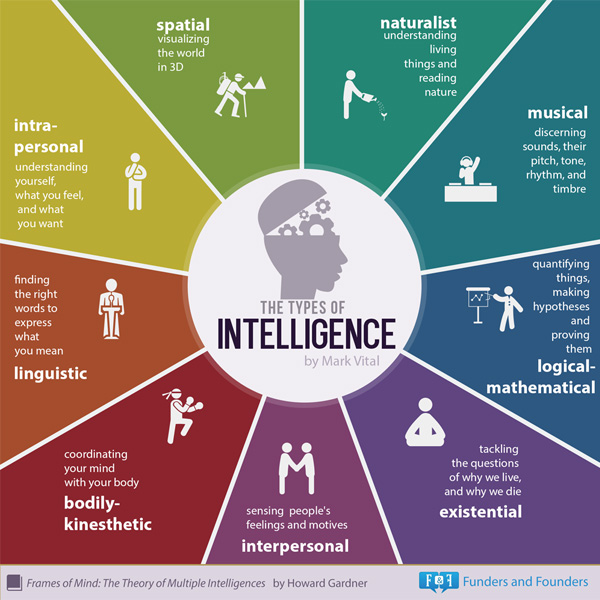
Let’s take a look at each of the 9 intelligence types and how you can cater for them in your training sessions or programme.
Spatial / visual intelligence.
People with high spatial intelligence are visual thinkers. They are particularly good at thinking in three-dimensional terms.

They visualise and mentally manipulate physical objects and perspectives with little effort. Think of how an architect visualises and manipulates space and you’ll get the idea.
This group are likely to be good at reading maps, recognising patterns, solving puzzles or drawing objects in the correct proportions.
They may also have an active imagination, a keen eye for detail or well developed graphic and artistic skills.
Here’s a list of common careers that require a good dose of spatial intelligence:
- Construction
- Engineering
- Architecture
- Any type of design (graphic, interior, fashion)
- Photography
- Astronomy
- Advertising
- Artist (particularly sculptors and painters)
- Filmmaker
How to train people with spatial / visual intelligence.
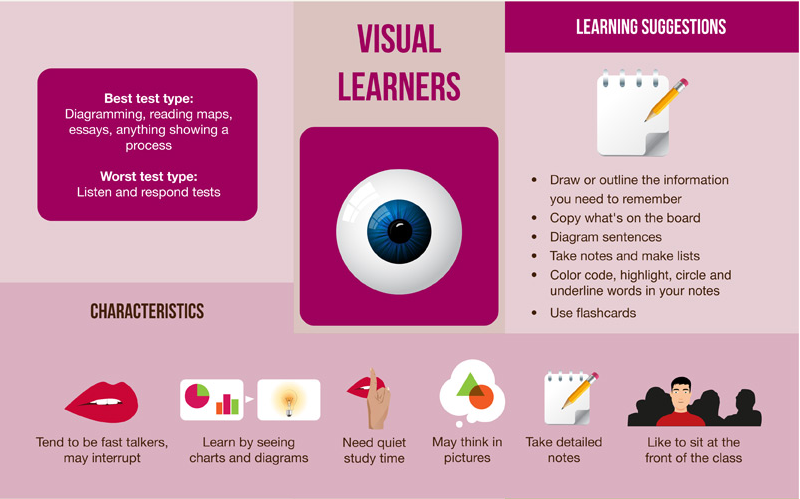
Unsurprisingly, this group responds best to visual stimuli.
To keep them engaged during training, use plenty of videos, images, charts, graphs, maps and diagrams to illustrate your points.
Other simple visual techniques, like colour coordination, highlighting and circling, for example, can also make it easier for visual learners to digest your key training concepts.
Naturalist intelligence.
Have you ever tried to distinguish between coriander and parsley? People with this type of intelligence have an above-average understanding of the natural world.
They find it easy to identify and distinguish between closely related species of animals and plants. They are also naturals when it comes to discriminating between similar cloud formations and rock configurations for example.
In our evolutionary past, this skill was essential for hunters, farmers and healers. It is useful in our current society in order to distinguish and identify the unique features of various similar consumer products like cars, smartphones or software for instance.
People with a high-level of naturalist intelligence may gravitate towards careers such as:
- Geologist
- Archaeologist
- Chef
- Botanist
- Zoologist
- Farmer
- Gardener
- Vet
- Marine Biologist
- Florist
How to train people with naturalist intelligence.

If you want to engage with this type of learner, the best way is to ditch the powerpoint presentation and head outdoors!
If this isn’t feasible, provide something physical they can interact with. This group find things much easier to understand if they have something tangible to work with.
This group also likes to get their hands dirty. Trainees with naturalist intelligence will therefore respond very well to training that is both active and hands on.
Musical intelligence.
Did you know that listening to music while training can actually help some people to take in what you’re saying?
Those with a high level of musical intelligence have a good understanding of rhythm, tone and pitch. They may also demonstrate a high level of mathematical skill due to the similarities between mathematics and music.
If you have a hummer, whistler or toe-tapper in your team, the chances are you’re dealing with someone who’s music-smart.
Careers that suit the musically intelligent:
- Musician
- Sound engineer
- Music critic
- Music therapist
- Speech pathologist
- Audiologist
- Dancer
How to train people with musical intelligence.
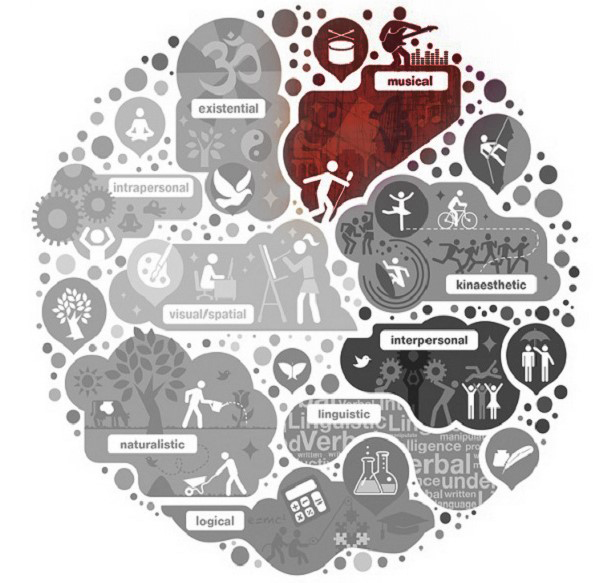
Those with musical or rhythmic intelligence respond particularly well to sound-based training techniques.
Catering for musically-minded trainees could be as simple as allowing them to record the training session.
You could also try incorporating a relevant podcast or including an element of rhyme or rhythm (like chanting or drumming on the desk for example) to your training sessions.
Musical learner’s find it very difficult to take in information if it’s too quiet. Play some background music, or ask if anyone would like to listen to music on their headphones while reading training materials to make life easier for this group.
Logical-mathematical intelligence.

Those with a high level of logical-mathematical intelligence tend to be good at abstract and symbolic thinking. They are skilled at reasoning, adept at using and understanding formulas and are likely to be comfortable with most mathematical concepts.
This group loves nothing more than to categorise and classify. Hypothesising, calculating and quantifying data comes naturally to them.
As you would expect, you’ll find a large proportion of the logical and mathematical thinkers in the scientific, engineering and computing industries.
Suitable careers for this group include:
- Accountant
- Mathematician
- Scientist
- Engineer
- Computer analyst / programmer
- Economist
- Lawyer
- Investment broker
- Pharmacist
How to train those with logical-mathematical intelligence.
Include logical and mathematical based activities in your training sessions. Provide plenty of opportunity for the analysis of data and/or problem-solving.
Present relevant theories, encourage measurement, conduct or analyse surveys, and frame concepts in terms of cause and effect.
Bodily-kinaesthetic intelligence.
This group has excellent motor skills and loves to move around. They are quite practical, learn by doing and value hands-on experience.
You’ll find a high proportion of this type of intelligence in the arts, manufacturing, trade and creative industries.
This type of intelligence is needed for the following professions:
- Mechanic
- Carpenter
- Physical therapist
- jewellery maker
- Athlete
- Actor
- Factory worker
How to train those with bodily-kinaesthetic intelligence.

This group responds best to practical training methods. A good training session might include a brief introduction or demonstration followed by the completion of a task.
Get trainees to have a go at the task early on and provide guidance and feedback as they proceed. Allow time in your training sessions for practice.
If you’re teaching a skill, be sure to first demonstrate it to cater to this groups ability to learn by shadowing.
Linguistic intelligence.

People with high linguistic intelligence are excellent communicators. They love words, have great vocabularies and can easily distinguish between subtle differences in meaning.
They are highly skilled at breaking down complex concepts and repackaging them in easy to understand ways.
Members of this group are likely to excel at reading, writing, speaking and listening.
Careers that suit linguistically intelligent people include:
- Journalist
- Marketer
- Teacher / Professor
- Public speaker
- Writer
- Manager
- Editor
- Copywriter
- Translator
- Critic
How to train those with linguistic intelligence.
Word-smart trainees will easily absorb training that involves reading, writing and verbal communication.
Encourage this group to talk through any procedures that you want them to learn. You could also provide written instructions during training.
Using communication-based role-playing exercises such as mock negotiations or sales calls to sharpen techniques can be particularly effective with this group.
Note that linguistic learners may find it difficult to interpret visual or spatial data such as maps or charts.
Intra-personal intelligence.
People with high intra-personal intelligence have a very good understanding of themselves. They are skilled at processing their own thoughts and feelings and use this to their advantage.
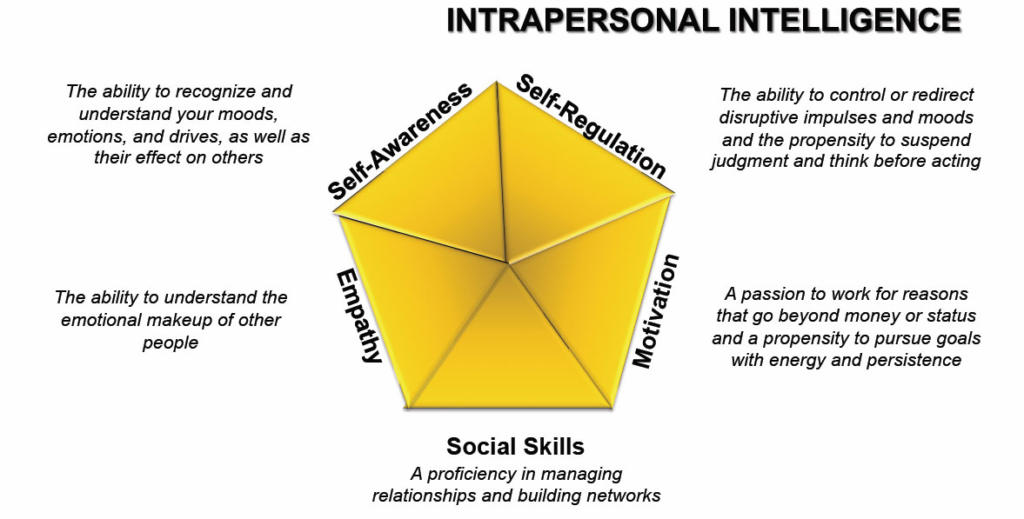
They are highly self-motivated and don’t need rewards to get the job done.
Many creatives, small business owners and entrepreneurs fall into this category. They are often (but not always) introverts who prefer to work and train alone.
Members of this group might gravitate towards careers like:
- Philosopher
- Psychologist
- Scientist
- Counsellor
- Historian
- Entrepreneur
- Artist
- Consultant
How to train people with intra-personal intelligence.
As a manager, dealing with this group can be difficult.
People in this group don’t need or appreciate direct supervision. It’s best in most cases to simply tell them what needs to be done and trust them to get on with it in their own way.
Interpersonal Intelligence.
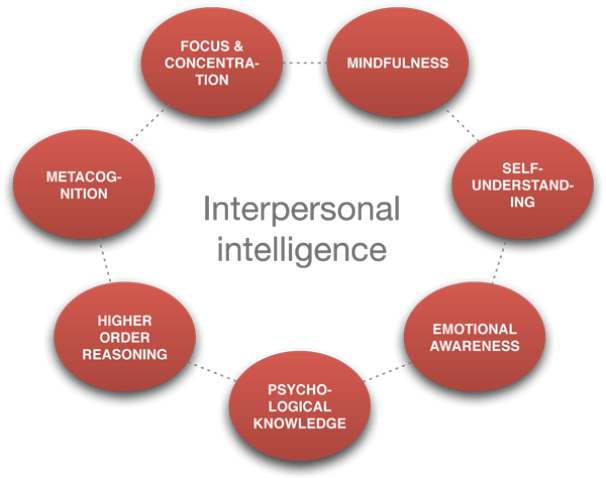
Like linguistic learners, those with interpersonal intelligence are excellent communicators. They thrive in a group or social setting because they learn best when they can relate to others.
They are very empathetic and are especially good at understanding other people’s moods and motivations. Because of that, they are likely to be fantastic leaders or team members.
Careers that might attract this group include:
- Social worker
- Customer service
- Actor
- Team Leader
- Manager
- Nurse
- Sociologist
- Public relations
- Receptionist
How to train people with interpersonal intelligence.
Members of this group are likely to take an active role in group activities and discussions.
They need someone to bounce off, so will respond best in training scenarios that involve either working in pairs or as part of a team.

Existential Intelligence.

If your industry requires thinking about questions that might not have a real or definite answer or studying collective values, you may find yourself training a member of this group.
A lot of managers themselves actually fall into this category because of their ability to “see the big picture”.
This type of trainee is going to have a good understanding of how their role fits into wider company objectives. They will appreciate how what they do on a day to day basis helps towards the end goal.
This group can easily envision the future of the marketplace and ensure that their actions and the actions of those around them are in line with current cultural and political developments.
Careers that might attract this group include:
- Philosopher
- Life coach
- Manager
- Public Speaker
- Instructor
- Psychic
- Cosmologist
How to train those with existential intelligence.

When training this group, you’ll need to clearly explain the purpose of the training and why it is necessary.
Frame the importance of the training in terms of how it will help to achieve wider company goals.
This group likes nothing better than to explore and challenge existing concepts and ideas, so expect to be asked plenty of questions!
Tips and resources for training in 2020.
As a manager, it’s your job to make sure that everyone has the necessary information and skills they need to be successful in their role. Be sure to make staff aware of any industry-specific opportunities to learn and develop their skills.
This might include compiling and circulating a list of relevant podcasts, webinars, software programs, blog posts, whitepapers and any other useful resources that will help staff keep up to date for example.
Familiarise yourself with relevant online resources:
Technological development and the growth of online learning means that managers now have a myriad of resources at their disposal. It’s a good idea to know what these resources are and how best to use them.
YouTube, TED talks and LinkedIn Pulse for example, are all great resources for employee training in many different fields.
You can also utilise relevant courses on websites like skillshare or Udemy. The advantage of using online resources is that they provide flexibility and allow your staff to train on the go.
It’s now fairly easy to create your own course or learning materials, you can use Google Drive to do this. Google Drive allows you to combine slides, videos and documents into one complete training resource.
You may have noticed that a lot of these sources are video-based. If you’re not using video in your training right now, start.
Video is huge, and it’s become the go-to place to learn:
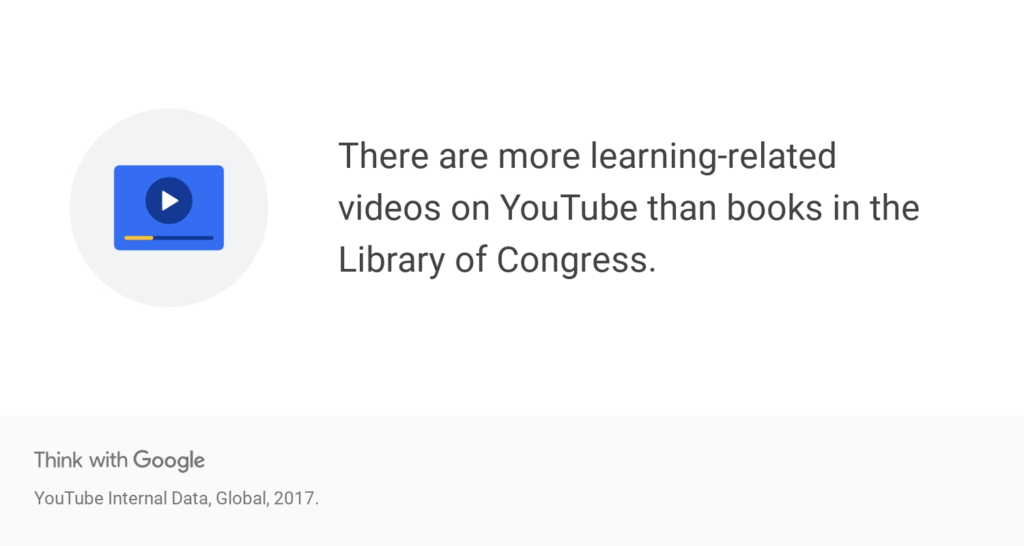
When traditional methods like PowerPoint and lectures are used to deliver training, the average employee will forget 65% of the information in a week.
Interestingly, simply adding video to your training can increase retention rates by up to 83% over time when compared to traditional methods.
Encouraging employees to create a short video demonstrating a particular skill is a great way to add a personal touch to your training programme.

There are lots of ways you can leverage social media in your training. Here’s a few ideas for you to think about:
1. Onboard with live streaming.
Live Streaming platforms like Periscope or Facebook live can be used to streamline the onboarding process.
Why not use them to provide a scheduled tour of the office, introduce coworkers and give new staff a sense of the work culture?
Both of these platforms allow comments, so staff can easily interact with whoever’s broadcasting and ask questions. Just make sure you change the default setting from public to private if you need to.
2. Encourage teamwork by setting up groups.
If you are training a team, setting up a Facebook or LinkedIn group is a great idea.
LinkedIn is a more formal option and is great for encouraging further discussion around the course materials.
Facebook groups are a little less formal and a bit more fun, so go with Facebook if you want to encourage staff to get to know one another better and create a strong team that works well together.
3. Connect experienced employees with trainees.

If you have experienced staff who are eager to share their skills and experience, you can use social networks to connect them with coworkers who want to learn.
This can be done via a Facebook or a LinkedIn group, or you could create a Twitter hashtag specifically for this purpose.
Make sure the method is fit for purpose.
It’s important that the method of training you choose is fit for purpose. Your approach will likely vary depending on the type of training you’re conducting.
Broadly speaking we can separate training into three categories.
- Onboarding and new staff training.
- Teaching existing employees a new method.
- Training designed to improve individual or departmental performance.
Depending on what your training goals are, you may decide to conduct on the job, one to one or group training methods. Demonstrations and shadowing can be very useful during onboarding, for example, as can mentoring.
To teach a new method, a combination of traditional classroom based learning and a hands on approach is best.
Drills and other practice based methods can be effective in improving individual performance. But you should always tailor your training to the worker’s preferred learning method for the best results.
How to organise your team.
Making Decisions.
As a manager, you should make all the big decisions, right?
Well perhaps not. While it can be tempting to make every decision yourself, doing so puts you under unnecessary strain and sends a negative message to your employees (that you don’t trust them).
An effective management strategy is to empower your employees by encouraging them to make their own decisions as much as possible where appropriate. This instills a sense of ownership and makes employees feel that you value their skills and experience.
Implementing strategies.
When it comes to organising your team’s efforts, building your strategies around problem solving is often the best way forward. For example, if you have a communication issue, speak to the staff, get to the root of it, brainstorm how to fix it and then go ahead and make the necessary changes.
Where possible you should involve your team in the strategic process and link employee incentives to a desirable outcome. Encourage discussions around strategy among your team and regularly act on their input and they will respect you all the more for it.
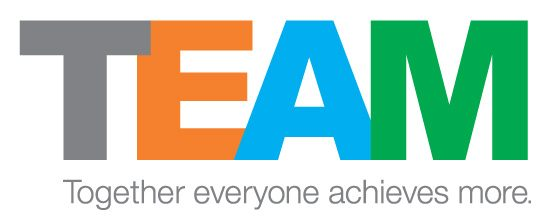
Be aware of the most common reasons that strategies fail so that you can overcome any obstacles to implementing them. The most common reasons strategies fail are:
Lack of ownership. You can overcome this by involving your team in the creation process.
Communication failure. Ensure that everyone is clear on how they should contribute.
Putting it on the backburner because you’re busy. Prioritise your plan and dedicate a portion of your time to it.
The plan is overly complex. Make sure the plan is easy to explain and to put into practice.
The benefits are not clear. Explain how and what the strategy will improve.
Progress is not being measured. Have a method in place to track progress and to give and receive feedback.
No accountability. Assign specific actions and responsibilities and follow up on them.
Here are some useful questions to ask yourself before you move forward with any strategy:
- Do I believe this plan is the best solution?
- Am I 100% committed to seeing this plan through?
- How will I communicate the plan to others?
- Are enough people invested in this plan to make it a success?
- How will I motivate people to achieve this?
- Do I have all of the resources I need?
- What are some likely obstacles and how can I overcome them?
Embracing self-interest.

Source.
Like it or not, people will always do what’s best for them. Don’t fight this. Instead, try to make it work for you by aligning the interests of your staff with the interests of the organisation.
If you are in any doubt about the merits of doing this (or you just need some ammunition to convince your boss) scroll back up and rewatch the Diana Dosek Ted talk video in the why training is important section above.
Getting the most out of your employees.
As a manager you need to be able to get good results from your employees. Your job pretty much depends on it. But figuring out how to do this isn’t always easy. It is achievable however, if you follow these useful tips.
1. Hire the best people you can find.
Notice I said “best” people you can find and not the most qualified people? That’s because the most qualified person may not always be the best fit for your company.
Don’t get me wrong, qualifications are important (as is experience) but look for staff that share the company’s values and whose attitude and personality will be a good fit too.
Don’t shy away from painting an honest picture of the job. If your clients are demanding and the schedule can get a little crazy, let candidates know. Similarly, be honest about the benefits.
That way, potential workers will understand exactly what is expected of them and you minimise the risk of them leaving in the first year.
2. Make goals crystal clear.
Do your employees know exactly what’s expected of them? Do they have clear goals to achieve or targets to work towards?
So many managers are vague about what they want from their employees. This ambiguity causes confusion amongst workers and inevitably leads the endless dishing out of discipline.
If you have goals in place that aren’t being met, chances are that they may be too vague.
Consider the difference, for example, between telling your employees that the the company “values fast response times” as opposed to telling them “we expect all emails to be answered within an hour.”.
To get the most out of your employees, avoid vague goals like “we need to improve our turnover” and instead set smart goals which you constantly update and provide feedback on.
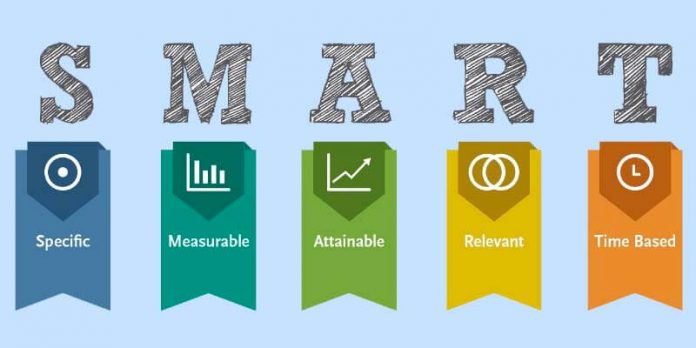
3. Encourage feedback.
Listening to employee feedback and ideas can make your job easier. Great managers recognise this and foster the type of environment where staff feel more than comfortable sharing their opinions.
Try creating surveys or polls to learn more about your workers experience and identify any improvements that might be made. You could also set up a confidential system for staff to log their complaints.
You can identify opportunities for training, highlight areas for increasing efficiency, and be made aware of when a system update is needed simply by asking your staff.
Actively encourage employee feedback at every opportunity. Use said feedback to inform your decision making processes..
When your employees feel heard and valued they will demonstrate greater loyalty and are likely to be much more invested in the company’s success.

If you want to get the most out of your employees, make sure your staff know that your door is always open and that their ideas are always welcome.
4. Know your team well.
Only 53% of employees feel that their managers care about their wellbeing. In fact, almost 60% of people would trust a stranger more than they trust their boss.
As you might expect, this has a huge effect on morale and is a major factor in overall workplace satisfaction. The knock on effect of this is that your bottom line suffers tremendously.
There are so many benefits to be gleaned from spending a little bit of time to get to know your employees better, the most important of which is to create trust.
Getting to know what parts of their jobs your employees like best is a suitable starting point.
Everyone likes some parts of their job more than others. But the good news is, everyone’s preferences are different.
If you have a team of staff that are all doing something similar, put a bit of effort into learning their individual preferences.
Divvy up the work according to what people like to do best and you’ll soon be everyone’s favourite boss.
The bonus? people are more productive when they’re doing something they enjoy. So, If you want a gold star in management, pay attention to the personal preferences of your staff and factor this in when you’re assigning the workload.
Get to know your team’s preferred methods of working and accommodate them as best you can. Ideally you should facilitate multiple ways of working, like providing a quiet space and a collaborative space for example.
Try to be mindful of staff morale as this can also be a big influencer on productivity. Keep an eye out for slumps in energy and be ready to perk up the troops if needed.
This could be as simple as buying your team an ice-cream in hot weather, or encouraging them to take 5 minute productivity breaks.
Use project management software to stay organised.
Organisation is a talent that not all managers possess. But even if you happen to be the most organised manager on the planet, keeping track of large projects that involve many employees can take up a lot of your energy and time.
Luckily, there are lots of software applications that are designed to make it super easy and efficient to keep track of projects.
Project management software suites are generally cloud-based and can be accessed by multiple users. This means that everyone involved in a project can track the overall progress and share knowledge in real time.
With agile project management software, in a few clicks you’ll be able to get a clear picture of who’s working on what and when. You can use it to set milestones, to keep track of time and resources and to keep employees focussed on deliverables.
The top 5 project management software options.
1. Wrike.
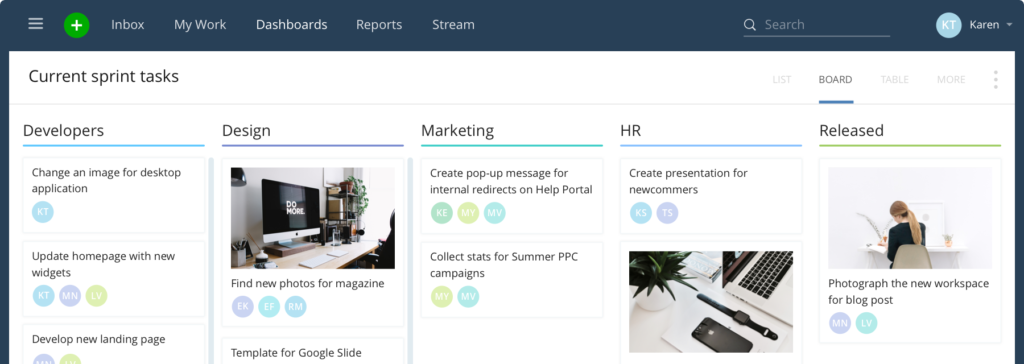
This award-winning platform has an impressive list of users including many Fortune 500 companies like Google, Stanford University, Adobe, EA Sports and Airbnb.
It’s loaded with collaborative tools and information management features including Interactive timelines, real-time news feeds and Google Docs, Dropbox and email integration.
It also has analytics which make it really easy to generate reports for upper management and stakeholders.
If you want to create a single hub that can be accessed by any worker no matter where they are in the world, this is the one to go for. Wrike can be accessed via mobile, (they have an app for both Android and iphone) and navigation is user-friendly. Their security is also top-notch.
There are 5 plans to choose from. If you have a small team, opt for the free plan which allows up to five core users, as well as an unlimited number of collaborators. Otherwise, prices range from $9.80 to $34.60 per month.
2. Monday.com
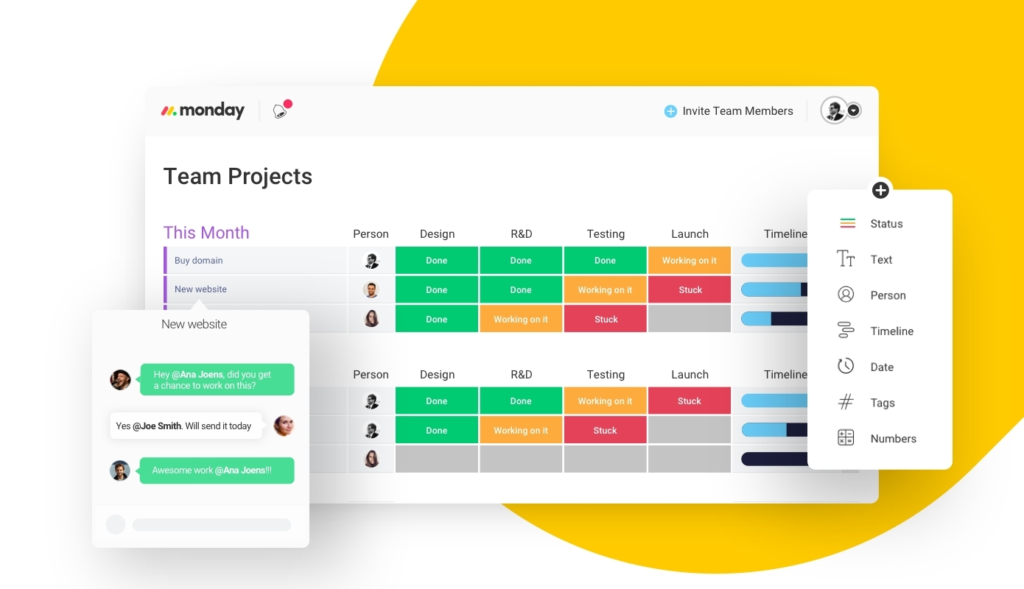
If your organisation thrives on collaboration, you might like to try monday.com. Not only does it sync all of your project information in an easily accessible hub, but it’s also designed to facilitate and encourage group decision making.
This software is unique in that it provides incentives for contributions to tasks and assignments, even from those staff members who are not directly involved in the project.
The system is highly intuitive and requires little to no training. Despite this, Monday.com still offers a variety of easily accessible training materials for novice users.
You’ll no-doubt benefit from its advanced scheduling capabilities which allow you keep track of individual projects as well as common goals. This can eliminate the need for a lot of paperwork.
If you want to keep everyone on the same page, work with multiple freelancers, and have the ability to customise your interface, look no further.
They don’t have a free plan, but they do offer a free trial. After that, it’s $25 per month for the basic package. You can upgrade whenever you like and monday.com guarantee a seamless transition across their packages.
The most expensive and comprehensive package is the Enterprise option at $118 per month.
3. Smartsheet.

If you like spreadsheets, this one’s for you.
This powerful and customisable spreadsheet-based system incorporates visual timeline management, file sharing and automated workflow options that can be accessed from any device.
It’s particularly useful for tracking finances, schedules and inventories. It can be easily integrated with Google Apps,Box and Salesforce too.
It allows collaborative input on a wide range of tasks such as tracking marketing campaigns and event planning. It’s a favourite among many businesses thanks to it’s user-friendly interface and numerous productivity-boosting features.
Smartsheet offers industry-specific solutions for those in manufacturing, technology, construction, retail, professional services and education. It also allows you to manage a wide range of departments from sales and marketing to IT and HR.
They offer a 30-day free trial and prices start at $14 a month for an individual plan. If you’re looking for a highly customised option with all the bells and whistles, you’ll need to contact smartsheet directly for a quote.
4. ProjectManager.

ProjectManager can easily accommodate the needs of most businesses, regardless of industry or project size.
It’s a very highly regarded, collaborative, award-winning cloud-based project management tool that’s used by NASA, Volvo and the United Nations.
It’s ideal if you have large scale projects that need to be broken up into lots of different detailed stages. But it can work equally well for small businesses too.
It handles planning, scheduling and resource allocation with ease, and you can monitor everything from a single dashboard.
It’s easy to make adjustments and updates are instantaneous. There’s an easy drag and drop feature for scheduling and facilities for comments and discussion.
The USP of this option is that it allows you to compare your planned progress with your actual progress, so you can easily identify issues and troubleshoot if things are going off track.
You can try any of ProjectManager’s packages for 30 days for free, and they have options at $15, $20 and $25 a month.
5. Meistertask.
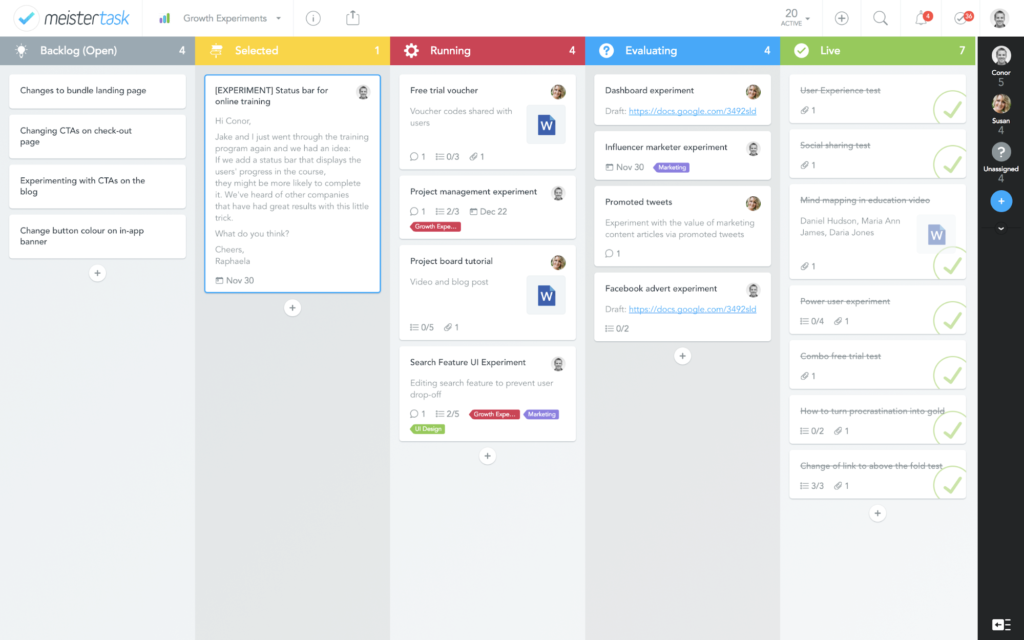
Meistertask is a little bit similar to Trello. It’s designed to help project managers stay in control of all aspects of a project, however, it also has the standard collaborative functions that you would expect from this type of software.
It works across multiple devices, and is a very useful tool for any business looking to boost productivity or streamline operations. It’s also compatible with Google Drive, Dropbox and Bitbucket.
It’s easy to create projects, assign team members to specific tasks and track each worker’s progress. The dashboard can be customised to show completed or pending tasks, daily reports or a broader overview.
For those in the creative Industries, the makers of Meistertask have also developed a mind-mapping tool which can be integrated with this software to allow for real-time brainstorming as well as collaborative project planning.
The basic plan is free, and allows you to manage an unlimited number of projects and tasks. However, you will be limited to 20MB of file attachments. If you want any more than that, you’ll need to upgrade to the Pro plan which gives you up to 250MB at a cost of $8.25 per month.
They also offer a business plan at $20.75 per month and an enterprise plan which is priced-up according to your needs.
There are so many great project management software options out there and the best way to find what works for you and your business is to shop around. Here’s a list of some of the best ones that didn’t quite make the top 5:
- Quire.
- Zoho Projects.
- Project Insight.
- ReQtest.
- Hive.
- Zoho Sprints.
- Vabotu.
- Intervals.
- Web work time tracker.
- Daptiv PPM.
The benefits of effective communication.
Studies have shown that effective work communication can improve overall company performance.
We also know that the most productive employees are also the ones that receive the most effective communication from their superiors.
If you want to increase productivity, build great working relationships with clients and staff, and to minimise workplace disagreements, effective communication is key.
Increasing productivity.

As we’ve already established, workers are more productive when they’re doing something they enjoy. People are also far more productive when they feel like they have a voice in the organisation.
Fostering good communication with employees allows you to gain an understanding of their individual needs and skills, as well as their likes and dislikes when it comes to specific aspects of the work.
All of this information makes it easier for you to assign specific tasks in order to maximise productivity.
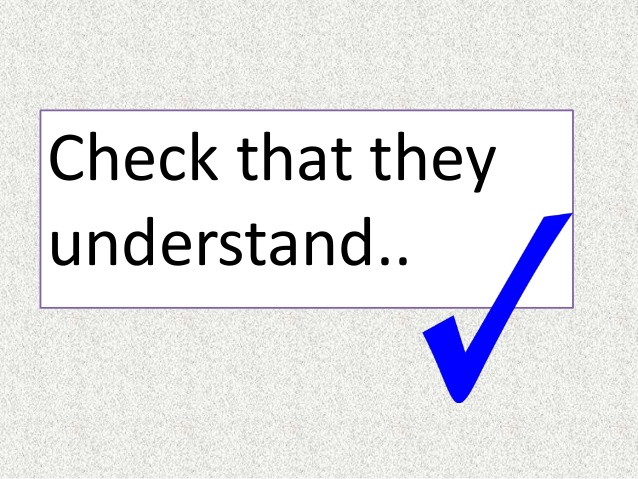
You can’t always rely on your staff to ask questions if they are unclear, as they may not always be comfortable doing this. So, as the manager, you need to explain requirements well and ensure that they are fully understood.
You need to be able to give clear instructions so that your team understand exactly what’s expected of them. Clear instructions help you to avoid confusion, which means that less time is spent clarifying instructions and correcting (costly) mistakes.
Reducing conflicts.

The chief cause of workplace disagreements is miscommunication. So it stands to reason that promoting good communication in the workplace can help to reduce these conflicts significantly.
People communicate differently, and sometimes things get lost in translation. Language barriers, cultural differences and individual interpretations can all cause misunderstandings in the workplace.
These common communication failures not only affect productivity, they also affect morale, so they need to be minimised and dealt with in a sensitive and fair manner.
As a manager, dealing with this type of conflict is fairly straightforward. You simply need to listen, find out what went wrong and put measures in place to avoid it happening again.
When it comes to dealing with conflicts, listening goes a long way. Make sure that your team knows that any concerns have been heard and that you have taken them on board.
If you are constantly dealing with communication issues, consider including a section on good communication in your training programme.
Improving client and staff relationships.
One of the main benefits to having good communication skills is that it allows you to build quality working relationships.
When you’re dealing with clients or customers, effective communication means repeat business and increased trust.
Poor communication on the other hand can have a negative effect on both your reputation and your profits.
Commit yourself to excellent communication at all the stages of your working relationships and you will be well regarded in your office and in your industry.
Companies that have good communication practices are more appealing to staff, and their workers tend to be absent less. Workers will generally be more willing to contribute any ideas they may have to further the business if there are good lines of communication.
10 tips to become a better communicator.
1. Listen and learn.

Good communication is all about active listening. That means no eyes glazing over, and no thinking about what your going to have for lunch!
You need to really pay attention to what people say so that you can respond in an appropriate and effective way.
Maintaining focus while someone else is talking can take practice, so make a point to work on it a bit every day. When you’re in a work conversation, show that you’re engaged by asking questions and offering your input.
2. Notice body language.

Learning to read basic body language can help you a lot in your work life. Take business meetings for example. Did you know that If someone’s got their legs crossed during a negotiation, it means that they are less likely to budge?
Is the person you’re talking to fidgeting, or are their feet and torso pointed slightly away from you? If so, the chances are that they’re eager to end the conversation.
Don’t just focus on other people’s body language though, pay attention to your own as well. Remember that you’re saying as much with your eye contact and smile as you are with your words.
3. Communicate in context.
Different methods of communication are suited to different contexts. The way you communicate when giving a presentation, for example, will be different from the way you communicate during an informal staff meeting.
If you’re unsure of how to communicate in a particular context, take your cues from how other professionals do it. If you’re giving a business presentation, study business presentations on Ted or youtube to see what works.
The same logic applies for communicating at networking events or parties.
4. Make a valuable contribution.
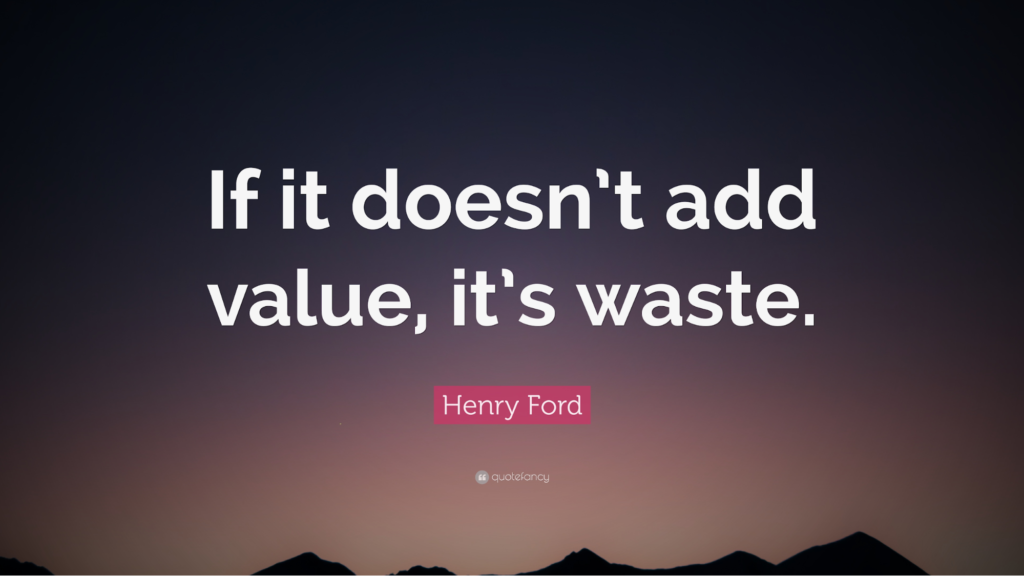
If you’re presenting or participating in a group discussion, you should always make sure that your material or comments add value.
Where you can, try to provide actionable advice or have a key takeaway that your team or audience can act upon soon after the talk.
In a group situation, people tend to tune out those who make comments just for the sake of it. you’ll gain far more respect if you choose to speak only when you have something important to contribute.
If you have a valid critique, make sure that your criticism is tactfully put across and is constructive. This is especially important during performance reviews.
There are lots of techniques you can use to ensure that your critiques of employees are tactful and constructive, like the feedback sandwich or using the passive voice.
Consider the difference between saying “you wrote a bad report” (active voice) and “this report is bad” (passive voice). Notice that in the second example the emphasis is on the report and not on the person. This means that the individual is less likely to take offence.
5. Keep responses short and snappy.
If you’re in a group situation and you’re giving a response, keep your answers short and to the point. This shows that you have good communication skills and also that you have respect for everyone’s time.
Long drawn out responses are inconsiderate, less likely to be retained and are far more likely to make people lose interest.
Good communicators understand the value of brevity. They know that by being specific and cutting right to the chase, they avoid their message being lost in a cloud of unnecessary words.
6. Validate.

It isn’t enough simply to listen. Good leaders also need to show understanding. To prove that you have understood a team members point, state it back to them and then validate it by giving your own perspective on the issue.
If people feel that their ideas and opinions have been honoured, they will be more likely to be open to your ideas and opinions too.
7. Ask questions.
Whether they’re talking to a single person or to a large crowd, good communicators always ask questions.
This is because asking questions is a great way to confirm whether or not you’ve got your point across successfully.
There is a subtle art to asking “checking for understanding” questions though. Continually asking if people are “following you” or if they “get what you mean” can get a bit annoying and come off as condescending if you’re not careful.
Instead, try phrasing your questions so that the focus is on you, and how well you’re explaining things rather than on your audience or staffs ability to understand you. Here’s a few examples:
- Am I explaining this well?
- Did I go into enough detail there?
- Was that explanation useful?
Of course, asking questions goes both ways. So, in addition to asking questions, you should always make sure that you provide the opportunity for others to ask questions during your meetings or talks.
Remember to ask questions yourself too, if you require clarification on someone else’s point during a discussion.
8. Show appreciation.

Before you get into a lengthy business conversation, be sure to thank the other person for their time.
In our busy lives, time has become an incredibly precious resource and this simple gesture of gratitude shows respect and consideration for the person you’re talking to.
If you want to start the conversation on an even more positive note, couple this with a statement of appreciation for their contribution or work. Appreciation and praise (or acknowledgement) can go a long way in building up a good rapport.
9. Connect on a personal level.

Establishing a real sense of connection can make all the difference in business. Good managers must therefore learn how to find common ground with employees, colleagues and bosses.
It’s important that you make an authentic connection. This isn’t always easy, but you’ll find that if you dig deep enough, you’ll have something in common with most people. Stay clear of topics like religion and politics as these are often seen as taboo.
If you’re willing to put in the time and effort it takes to get to know people a little better and genuinely connect with them, you’ll find that you are well thought of, and that the outcomes of your business dealings are far more likely to be positive.
10. Focus on the result.
It’s easy to get lost in a conversation, that’s why it’s important that you keep the result or goal of the conversation in mind.
Before you enter into a conversation, establish what the goal is. Maybe you want to get a certain point across or you need some information to help you make a decision.
Whether you’re seeking advice, resolving a conflict, or managing a collaboration, having a clear outcome in mind will help you to keep your work conversations on track, saving you and your employees time.
Leading and motivating.
Making the leap – insights for new managers.
Dr Axel Zein’s Ted talk entitled “The Perfect Boss” is a great resource for new managers. It’s just under 16 minutes long, and if you have the time, I highly recommend that you watch the full video below:

In the video, Dr Zein explains that 60% of workers are not engaged with their jobs. Not because of low wages or poor working conditions, but because of a “bad boss”.
He suggests that the reason there are so many “bad bosses” is because managers don’t understand (or are not taught) that being a manager is about serving other people.
He points out that when you go from being an employee to a manager you lose an element of control. As an employee, your role is defined by what youdo, but as a manager your role and your success are defined by what other people do.
Being a great manager then, means mastering the art of getting the best out of other people.
The trouble is, management training based on this philosophy simply doesn’t exist because the culture that we live in is too highly individualistic. So what needs to happen?
Well, Zein suggests that managers need to acquire a unique set of skills that are very different to those relied on as an employee.
All managers need to learn leadership and people skills, to figure out how to create a high-performance culture, how to give feedback without demoralizing, how to hire the right candidates and how to fire someone with decency. These are all things that managers today are rarely taught.
As a new manager, if you want to fully prepare for your role you should dedicate some time to researching and acquiring the skills mentioned above. So where do you start?

According to Zein, there is much to be learnt from studying professional team sports. In team sports, there is always a clear goal and a clear strategy in place to reach it. Individual performance is also clearly visible. The same, he says, should be true for business.
Like the captain of a sports team, a good manager should facilitate constant training, create a culture that values individual performance, select the right person for the right position in the company, and encourage the team to celebrate their victories.
What it takes to be a great leader.
The world is changing rapidly and leadership roles have evolved.
The stereotypical image of a manager as a commanding presence, as an authority figure who knows and sees all, is simply outdated. And so too are the many leadership development programmes that are based on this old model.
A study carried out on 4000 companies that was designed to test the effectiveness of their leadership training programs, found that 58% had failed to produce great leaders.
Leadership expert Rosalinde Torres, drawing on her 25 years of experience working with great leaders everywhere from fortune 500 companies to non profit organisations in Africa, has identified 3 of the key characteristics of great leaders in the 21st century, they are:
The ability to anticipate and shape the future of their business.

Good leaders don’t just adapt to changes, they see them coming. They actively follow trends and strive to keep up to date with everything that could have an impact on their company, including cultural and political as well as technological developments.
The ability to create diverse networks.
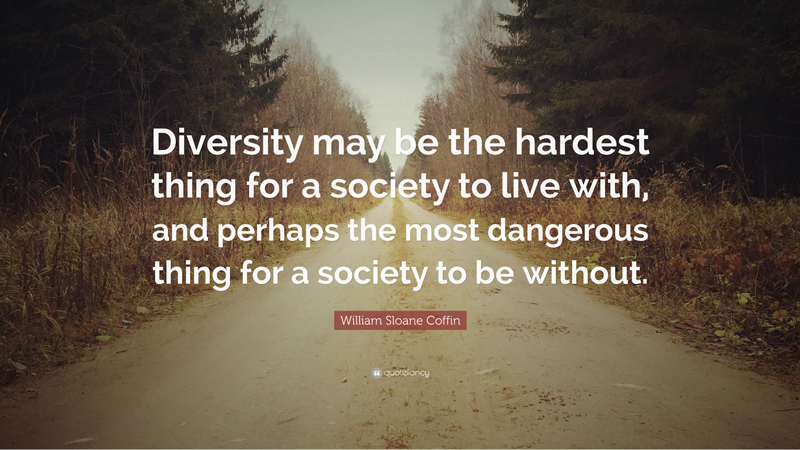
Great leaders make effort to cultivate relationships with a diverse range of people. This could mean connecting with people from different political, cultural, socioeconomic or geographical backgrounds, or it could be that they strive to include people with a variety of skill sets or from many different disciplines into their organisation.
They are brave enough to take risks.

The best leaders aren’t afraid to change their practices, even the ones that have proved successful in the past. Rather than doing what’s familiar and comfortable, truly great leaders actively seek out new challenges and adopt new ways of doing things.
Sometimes, this means that they are met with negativity, but really great leaders don’t listen to the naysayers, they simply moves forward with conviction.
How to motivate people.
As a manager, you’re being judged on the work that other people produce. So, motivating employees is perhaps the most important part of your job.
It’s also difficult terrain to navigate because everyone’s different and there’s a lot of “noise” around this subject which means it’s easy to get confused by conflicting opinions. That’s why made it simple for you by digging out the best 5 TED talks for managers on motivation.
5 great TED talks for managers on motivation.
1. What makes us feel good about our work? Dan Ariely.
Why do people climb mountains? And what does this reveal about motivation?
Dan Ariely is a behavioural economist and author of several books including Predictably Irrational: the hidden forces that shape our decisions. His 2014 TED talk explores the reasons why we work.
This interesting and informative talk presents two experiments which demonstrate that rather than being motivated by money and happiness as most people believe, we are in fact driven by the need to progress and experience a sense of purpose.
2. The puzzle of motivation. Dan Pink.
This video will change the way you think about employee incentives. As Dan explains, offering traditional rewards like money could actually be hurting your business.
So how you do you incentivise workers then? Well according to Dan, you need to focus on intrinsic instead of extrinsic motivators.
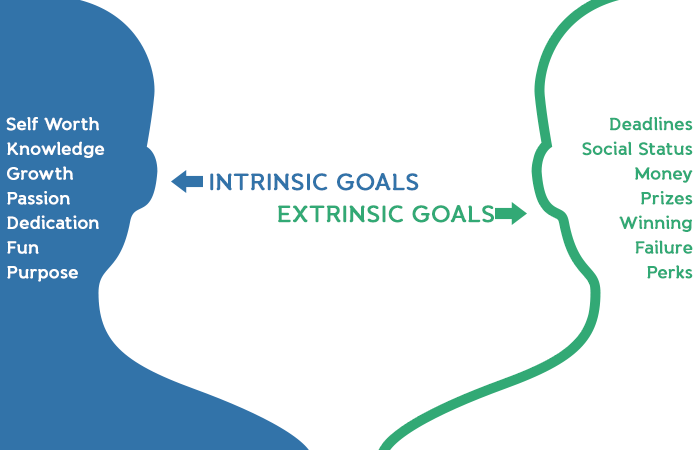
This means as a manager you should do the following 3 things.
- Give people ownership and autonomy over their work. If you want a motivated team, you need to allow your employees to dictate the direction of their own work wherever possible.
- Provide opportunity for mastery. – This means encouraging people to learn and improve their skills in order to grow.
- Give workers a sense of purpose. – People are more highly motivated when they understand why their work matters. Explain why the work they’re doing is important and make sure that all employees understand the “why” of the company mission as a whole.
3. Why we do what we do. Tony Robbins.
This talk is worth watching just to see Tony Robbins hi-five Al Gore in the front row!
Considering that this life coach’s leader psychology seminars are usually 55 hours long, he did pretty well to create a TED talk that was under 22 minutes.
In why we do what we do? Tony Robbins talks about the power of emotions and the role that emotion plays in the key decisions we all have to make in order to drive our success.
4. The power of believing that you can improve. Carol Dweck.
If you want to understand what it means to have a “growth mindset”, then check out this 10 minute offering from Stanford University professor, Carol Dweck.
She talks about how through simple belief, we can increase our brain’s capacity to solve problems.
She highlights the importance of encouraging people to learn and grow, and stresses that this is necessary in order to create a team that is able to easily overcome obstacles.
5. The psychology of self motivation. Scott Geller.
If you want to know how to inspire people to motivate themselves and/or increase your own motivation then check out this 16 minute talk from psychology professor Scott Geller.

Gellar suggests that if you want to find out if your team are motivated, you should ask them these three simple questions:
1.Can you do it? Find out whether your staff believe that they can achieve what you’re asking them to do. Ask them if they have the knowledge, the training and the time to complete the task.
- Will it work? Do your staff believe that if they follow the procedure they have been given, that they will achieve the desired outcome? If you can prove that your methods are effective, for example with data, then that would be really useful.
- Is it worth it? Do your staff feel that this is a worthwhile use of their time and are they getting adequately compensated? This doesn’t just refer to money but can also refer to whether or not they will get good feedback.
If you get a “yes” to all these three questions then you have nothing to worry about, however, if you get a “no” to any of these questions it means you’ve got some work to do.
Top 5 ways to motivate employees.
1. Communicate with them.

This means listening to their concerns, asking for their their input and telling them when they’ve done a good job. Your staff will be much more likely to want to do well for you if you’re approachable, friendly and often give them praise.
As a manager you need to be more than just a face on the company website or a name on an email. Getting out of the office and simply talking to your employees more means that they will be more likely to want to help you succeed.
2. Set the example.
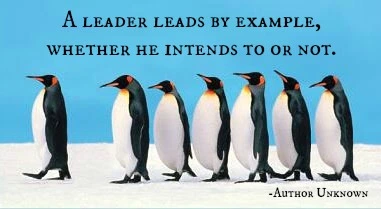
As manager, people will often look to you to see how to behave. Remember that your energy is influential.
If you’re engaged, enthusiastic and motivated, this is likely to set the tone in the office. However, if you are stressed and grumpy then your employees will pick up on this too.
3. Empower your staff.
Let your team have a say in how they do their jobs. Encourage them to give their input and ask for suggestions on how they think they could improve their performance.
You’ll find that most employees will have some valuable input on how to increase efficiency but they might not feel comfortable sharing unless you’ve created the right environment for them to want to!
Show staff that you value their input and encourage them to give more by acting on their advice and suggestions.
If you want to empower your team, encourage them to show their own initiative and don’t create an environment where they feel they need to run every little thing by you before they can act.
Final thoughts.
In many ways being a great manager is the same thing as being a great person.
The best managers understand people. They understand their differences, their similarities, their motivations, their emotions and their challenges.

One thought on “How to Be a Good Manager: The Ultimate Guide for 2020”